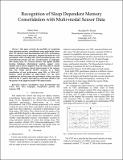Recognition of Sleep Dependent Memory Consolidation with Multi-modal Sensor Data
Author(s)
Sano, Akane; Picard, Rosalind W.
DownloadPicard_Recognition of sleep.pdf (855.0Kb)
OPEN_ACCESS_POLICY
Open Access Policy
Creative Commons Attribution-Noncommercial-Share Alike
Terms of use
Metadata
Show full item recordAbstract
This paper presents the possibility of recognizing sleep dependent memory consolidation using multi-modal sensor data. We collected visual discrimination task (VDT) performance before and after sleep at laboratory, hospital and home for N=24 participants while recording EEG (electroencepharogram), EDA (electrodermal activity) and ACC (accelerometer) or actigraphy data during sleep. We extracted features and applied machine learning techniques (discriminant analysis, support vector machine and k-nearest neighbor) from the sleep data to classify whether the participants showed improvement in the memory task. Our results showed 60–70% accuracy in a binary classification of task performance using EDA or EDA+ACC features, which provided an improvement over the more traditional use of sleep stages (the percentages of slow wave sleep (SWS) in the 1st quarter and rapid eye movement (REM) in the 4th quarter of the night) to predict VDT improvement.
Date issued
2013-05Department
Massachusetts Institute of Technology. Media Laboratory; Program in Media Arts and Sciences (Massachusetts Institute of Technology)Journal
Proceedings of the 2013 IEEE International Conference on Body Sensor Networks
Publisher
Institute of Electrical and Electronics Engineers
Citation
Sano, Akane, and Rosalind W. Picard. "Recognition of Sleep Dependent Memory Consolidation with Multi-modal Sensor Data." In 2013 IEEE International Conference on Body Sensor Networks (BSN), 6-9 May 2013, Cambridge, MA, USA.Pp. 1–4. IEEE.
Version: Author's final manuscript
ISBN
978-1-4799-0331-3
9781479903306